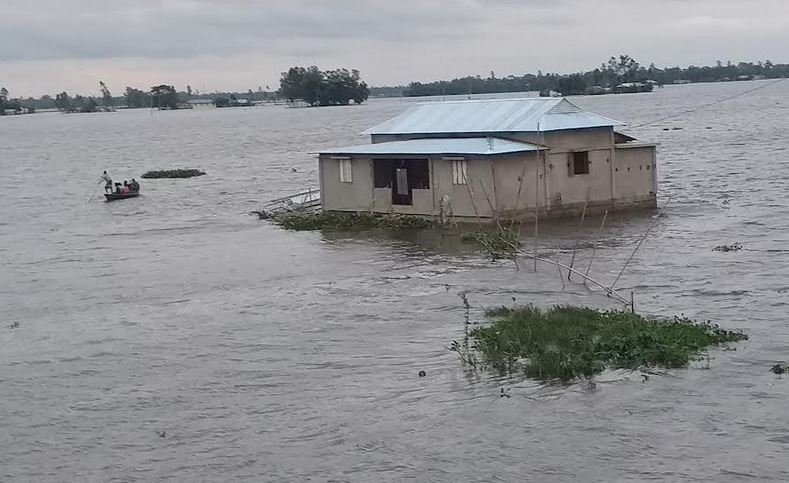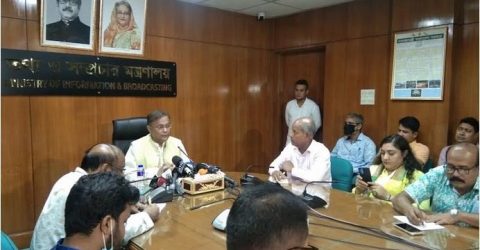
People of the northern and northeastern districts of Bangladesh are fearing a second spell of floods as major rivers continue swelling amid torrential rain and onrush of water from upstream.
“Both northern and northeastern parts of Bangladesh this year witnessed severe flooding, which is the worst one since 2004…. The devastating flood started on June 15 and it was getting improving trend after a weeklong wrath of the deluge,” an official of Flood Forecasting and Warning Centre (FFWC) told BSS.
But the flood situation in north and northwestern is getting worse again after swelling of major rivers as inside Bangladesh and upstream regions recorded heavy downpour in the past few days , said Md. Arifuzzaman Bhuyan, Executive Engineer of the FFWC.
Water levels at 39 river stations monitored by the FFWC have marked rise while 60 stations recorded fall.
Among the 109 monitored stations, 10 river stations have been registered steady while water levels at 10 stations are flowing above the danger level, a bulletin issued by the FFWC said here today.
The Dudhkumar at Pateswari, the Dharia at Kurigram, the Brahmaputra at Hatia, the Upper Atrai at Bhusirbandar, the Surma at Kanaighat, the Kushiyara at Amalshid and Sheola, the Old Surma at Derai, the Baulai at Khaliajuri and the Someswari at Kalmakanda are flowing above danger level by 87cm, 114cm, 42cm, 12cm, 01cm, 22cm and 07cm respectively.
Significant rainfall was recorded at some stations in different districts during the last 24 hours ending at 9 am today, the bulletin added.
A total of 185 mm (millimetre) rainfall was recorded at Sunamganj, 85mm at Kanaighat (Sylhet), 100 mm at Chattak (Sylhet), 76mm at Jariajanjail, 85mm at Lorergarh and 60mm at Sheola (Sylhet).
Significant rainfalls (mm) recorded during last 24 hours in Sikkim, Arunachal, Assam, Meghalaya and Tripura regions of North-East India, the bulletin added.
A total of 121mm rainfalls were recorded at Cherrapunji (Meghalaya) and 49mm at Jalpaiguri (West Bangal),
All the major rivers in the country are in rising trend except the Surma-Kushiyara, which may continue in next 48 hours, the FFWC bulletin added.
In the next 24 hours, there is chance of heavy rainfall at places of the northern and north-eastern Bangladesh along with Assam, Meghalaya and Sub-Himalayan West-Bengal (Jalpaiguri, Sikkim) of India, it added. As a result, basically the major rivers of northern Bangladesh (Teesta, Upper Atrai, Dharla, Dudhkumar, Upper Karotoa, Tangon, Punarbhaba and Kulikh) may rise rapidly at times during this period, the forecasting centre said.
The water level of Teesta river at Dalia Point, Dharla river at Kurigarm point and Dudhkumar river at Pateswari point may remain close to danger level in next 24 hours, the bulletin said adding flood situation in Sylhet, Sunamganj, Netrokona, Kishoreganj & Brahmanbaria districts may remain steady in next 24 hours.
Waterborne diseases are spreading in the flood-hit regions of Bangladesh as floodwater started receding.
“Many people are suffering from diarrhoea, skin diseases, dysentery, cholera and other waterborne diseases,” Directorate General of Health Services (DGHS) sources said.
In the past 24 hours, a total of 416 people have been affected by diarrhoea in four flood hit divisions — Sylhet, Rangpur, Chattagram and Mymensingh — while 1125 people have also suffered from skin diseases, a press release issued by the DGHS said.
To provide healthcare supports to the flood affected regions of the country, as many as 2,048 medical teams have been working since beginning of the flood, it added.
In Sylhet district, vast swathes of Sylhet region were hardly hit by devastating flood this year. Millions of people in the district have been badly affected by the ongoing flooding, officials and local residents added.
Roughly five millions of people were marooned during the flood, they said adding a large of number of people still have been marooned by the floodwater.
Monsoon rains and gushing waters from upstream India worsened Bangladesh flood situation with experts calling it one of the worst floods while millions of people have been affected by the deluge, the Bhuyan said.
Northeastern and northern parts of Bangladesh may witness prolonged flood as record breaking rainfalls were recorded inside Bangladesh and upstream states of India during the ongoing flood.
“We have seen that both Bangladesh and upstream states of Meghalaya and Assam and western Himalayan regions of India recorded heavy rainfall, the highest over 100 years,” Professor Md Mansur Rahman of Institute of Water and Flood Management of BUET said.
Major rivers and their tributaries of Bangladesh have no capacity to contain such huge volume of rains, which ultimately has caused massive flooding in northeastern and northern regions of the country, he added.
Mansur said there is a huge gap between Bangladesh and upstream regions of India in terms of elevation from sea level. “So, onrush of water enters Bangladesh with a faster pace, which inundated vast areas of the country in a shorter time,” he added.
The hydrologist said a large number of embankments have been built in both Bangladesh and Indian regions to control flow of water of major rivers, which are the main reasons for increasing frequency of flooding.
The ongoing flood in Meghna basin may prolong as “the only exit point of flood water is Bhairab at the Megna river will take much time to pass such huge volume of flood water into the Bay of Bangal… meaning flood in northeastern region is likely to be prolonged, if the heavy downpour continue.”




